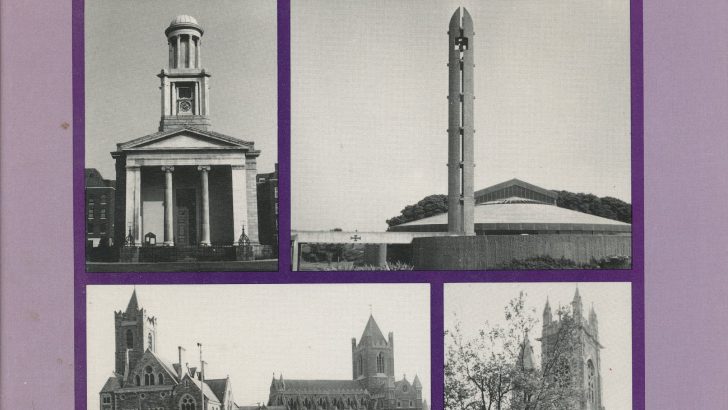The World of Books by the books editor
A writer’s words often come back upon him in surprising ways. It is one of the problems of writing anything at all. I learnt this the other day in relation to my own words.
The British Newspaper Archive website has recently added a further tranche of Irish papers to its site, covering a wider range of dates. While exploring these for the final decades of the last century, I came upon an article in January 1990 by Des Rushe of the Irish Independent reviewing my book Dublin Churches.
Des Rushe liked the book, but the real shock for me was not in what he said, but what he quotes at length from what I wrote.
The book dealt with 150 places of worship and prayer in Dublin – these out of a total count of 400 which I originally listed. These included not just parish churches, but also convents, chapels, bethels, synagogues, and even Dublin’s then solitary mosque.
It deals, too, with a few which had vanished, to make room for a Labour Exchange, a wax museum, an office block, and a tarmacadamed carpark.
In the introduction, I wrote: “Dublin is a Christian city. Few streets are out of sight of a church steeple or tower; few homes out of hearing of bells ringing the Angelus or summoning the faithful to Sunday services. Behind these sights and sounds…lies 1,500 years of tradition”.
But later doubts assailed me.: “Dublin is a Christian city”: is this still true, I asked?
“A major impression left after the research for this book is that it is not. Everywhere we found locked and vandalised churches, Catholic and Protestant. This is no longer for some priests and rectors a matter of surprise, but it was for me.
“For the malicious, under-employed, poorly-educated youth of the city, a church is just another badly-preserved building to be covered in graffiti, broken into, desecrated, vandalised, burned down. We found Fascist and Satanic symbols on Coolock’s Anglican church, the pledges of young lovers on the doorjambs of Donnycarney Catholic church; such things speak for themselves. They are omens of the future …”.
Des Rushe thought that “leadership” was the answer. But what I find striking are my remarks on places of worship that have fallen into disuse.
“Churches are a special kind of public, rather than private, property. To close them is to rip out the fabric of a community. They belong to the community because the community has paid for them…
“I began this survey thinking that when a church was redundant a tasteful conversion into something new, like offices, was the answer. Now I am not so sure. When a building such as a church is converted to private use, the whole community suffers a loss.
“I now think that the only role for these churches is another form of community use. An example has just come to hand.
“The Free Church in Great Charles St., a fine building dating from 1800, has been sold to a charity who plan to use it as an education centre for Travellers. The need to preserve the building has been met by filling an even greater need to an under-privileged section of society. No more nice offices, then. Churches are people’s architecture. Let them belong to the people”.
Today, so many years later, citizens will be aware of even greater changes.
Then there was merely indifference to cope with. Now there seems to be positive malice at large in the city, not perhaps to the many established smaller churches and the new places of worship connected with the “new Irish” communities, such as the Sikh temple in Sandymount and the Chinese Grace Church, and the Seventh Day Adventists in Ranelagh, who seem to be mostly Nigerian, as are the Methodists in Abbey Street.
But the Catholic Church seems in a sense devoid of the community spirit these new groups all display. Perhaps the up-coming events at the end of this month may show a different spirit.


 Peter Costello
Peter Costello Dublin Churches by Peter Costello
Dublin Churches by Peter Costello 